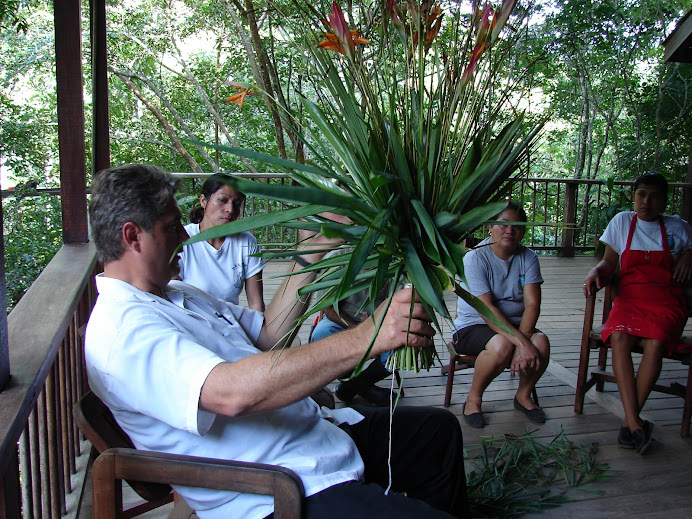
Ben, standing in front of main temple in Tulum, Quintana Roo, México
Travel is so exciting. I love to see ruins. I observe so many plants and flowers around them too. Once I was strolling through Tikal, in Guatemala, the morning after a violent thunder storm. Bromeliads littered the path, having been blown or washed out of the estuaries above. Tillandsia, Bilbergia, countless others, bright as birds, were scattered as if faeries had sprinkled them in anticipation of our arrival. Now, when I place an exotic bloom in a floral design, I think of where that bloom grows in the wild, or where it is being cultivated for harvest.

These two fotos are taken in the Jamaica flower market in México City. The palms above are Chamaedorea, referred to as "Camedor" by the growers in Veracrus, México.
The foto below shows how this palm is used by florists in México for sympathy and special occasion, often very large designs. Note the intricate structure of one of these displays on the backside to the left.

In the foto below, note the bunches of roses crammed into the back of a pickup truck. The care and handling of plant materials in the market is not state of the art, but the volume, variety, and price were delightful.

I notice a trend toward more unusual greens and flowers during the past few years, and have since traveled through the jungles to see where these things originate. There is a concern in some parts of the world that plants over-harvested will disappear. There is evidence of that in parts of Guatemala. The Mayan word for the highly desired chamaedorea species is "xáte." There are "xatéros," people who harvest, gather, and export the precious palms to the floral wholesalers. In México it is referred to as "Camedor." On the dutch flower market in Aalsmeer it shows up as "pico leaves," or "Cocus nucifera," In the US, many florists have referred to it as "emerald" for years. It also shows up with other names, like "jade."
 Rare tropical blooms like the Bromeliads I just mentioned above can be found in some of the local markets throughout Latin America. I saw bundles of them in the Jamaica market in México City--for pennies. I wondered just how many of those would be harder to find after such a thorough harvest. I spoke with people as I traveled there in 2006 about controlling that harvest. If people could come to understand that there is plenty out there, especially when they learn to cultivate these plants, and harvest them with the idea of leaving some for future growth, many more generations will be able to enjoy such things.
Rare tropical blooms like the Bromeliads I just mentioned above can be found in some of the local markets throughout Latin America. I saw bundles of them in the Jamaica market in México City--for pennies. I wondered just how many of those would be harder to find after such a thorough harvest. I spoke with people as I traveled there in 2006 about controlling that harvest. If people could come to understand that there is plenty out there, especially when they learn to cultivate these plants, and harvest them with the idea of leaving some for future growth, many more generations will be able to enjoy such things.Developing countries are aptly named, as much is happening to improve the lives of the citizens and more commodities are made available by international mass-marketers. Yet the rapid nature of this change demands products. Our floral tastes are equally insatiable, and world demand for the unusual is pushing some areas into the limits of product availability. The industries seeking plant materials in these regions, well, in any regions of the world, should be very responsible, avoiding over-harvest, and promoting long-term development of these lovely things. It is the responsibility of the consumer to find out where they come from too. We might think more carefully about purchases if we were more conscious of origin.

above, Ben in La Venta, near Villahermosa, México

Ben atop the pyramid of the Moon, looking over the shoulder to the pyramid of the Sun, Teotihuácan, México
 Ben, with son Anthony in front of Xunántunich, Belize
Ben, with son Anthony in front of Xunántunich, Belizein front of the castle Tsaravetz, near Veliko Turnovo, Bulgaria, Eastern Europe


